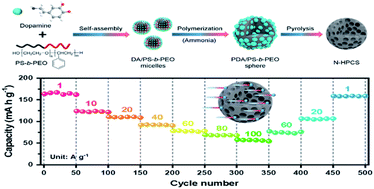Minimization of ion transport resistance: diblock copolymer micelle derived nitrogen-doped hierarchically porous carbon spheres for superior rate and power Zn-ion capacitors†
Abstract
Although tremendous progress has been made in exploring high-energy-density aqueous Zn-ion capacitors (ZICs) recently, their rate capability and power density still remain great challenges. Herein, diblock copolymer micelle derived nitrogen-doped hierarchically porous carbon spheres (N-HPCSs) were fabricated for high energy aqueous ZICs with superior rate performance and power density. It was found that the reasonable pore size distribution and nitrogen-doping of N-HPCSs are favorable for mass transportation by smoothing and reducing the diffusion routes, leading to efficient and fast Zn-ion storage. Consequently, the as-assembled aqueous N-HPCS ZIC yielded a high capacity of 180.4 mA h g−1 at 0.5 A g−1, superior rate performance of maintaining 58.3 mA h g−1 even at an extremely high current density of 100 A g−1, a high energy density of 144.3 W h kg−1, and an excellent power density of 79.9 kW kg−1 with an ultrafast charge time of 2.1 seconds. Moreover, the aqueous N-HPCS ZIC displayed an exciting capacity retention of 98.2% after an ultra-long stability test of 50 000 cycles. This work proposes an efficient strategy to design high-performance electrodes for ZICs with ultrafast Zn-ion storage.

- This article is part of the themed collection: Journal of Materials Chemistry A HOT Papers


 Please wait while we load your content...
Please wait while we load your content...